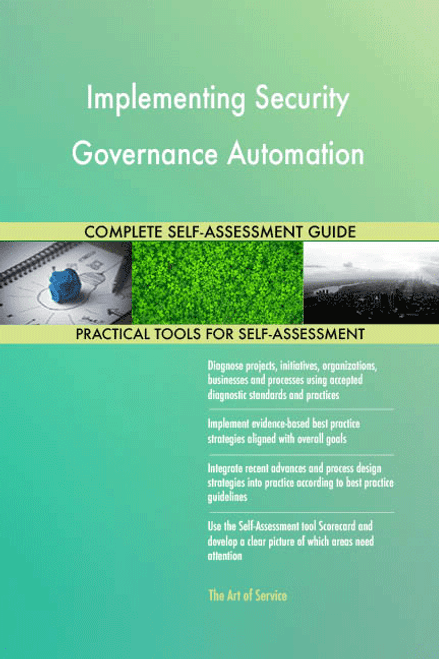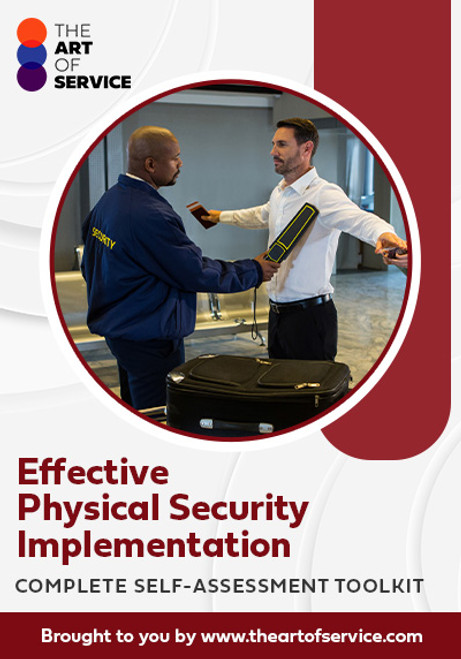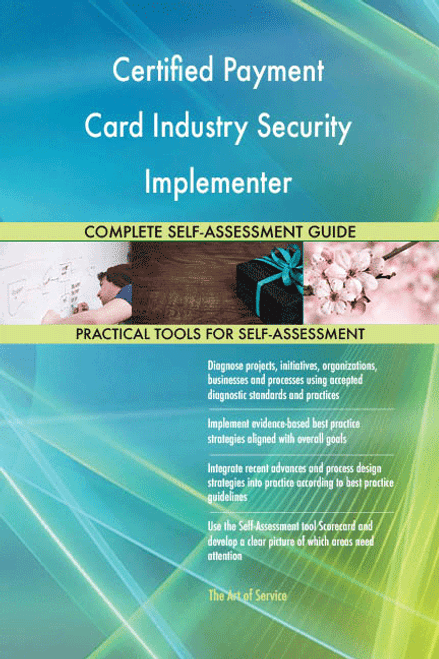Devise Security Implementation: filter information to draw inferences, create solutions, and adjust strategies to maximize thE Business and drive the merchandising process forward.
More Uses of the Security Implementation Toolkit:
- Organize Security Implementation: Enterprise Networks, voice systems, enterprise wireless, Information security or Penetration Testing, and network and Security Implementation.
- Consult on projects or project manage Security Implementations and development.
- Drive Security Implementation: Technical Support in the areas of Vulnerability Assessment, Risk Assessment, Network Security, Product Evaluation, and Security Implementation.
- Identify opportunities for updated or new policies and Standard Operating Procedures associated with changing technology and Security Implementations.
- Orchestrate Security Implementation: review Application Architectures and implementation details for design flaws, incorrect Security Implementation and missing Security Controls.
- Capture requirements; build functional specifications, timelines, adoption plans and other artifacts to support Security Implementation.
- Ensure you forecast; Lead the creation and or maintenance of policies, Security Metrics, standards, baselines, and guidelines.
- Ensure you conduct; lead Incident Response efforts coordinating response activities across teams while communicating updates to Executive Management.
- Lead and lead considerations to drive Security Controls in design and architecture of the IT infrastructure and applications.
- Initiate Security Implementation: implement Security Policies and solutions which balance between the need to secure your organization while also allowing business and functional teams the freedom necessary to complete the tasks in a high velocity Development Environment.
- Have or obtain your new security clearance at the Top Secret level.
- Evaluate technology solution privacy, confidentially, and Security Controls for compliance with organization, regulatory, and legal requirements.
- Apply technical knowledge to architecture security solutions that meet business, IT, Regulation and Compliance needs, infusing key security technologies where appropriate.
- Be accountable for recommending and incorporating Data At Rest and Data In Transit encryption practices.
- Coordinate Security Implementation: review current intelligence for relevant threats and develop appropriate actions/response or improve Techniques, Tactics and Procedures.
- Confirm your operation assess vulnerabilities to ascertain if additional safeguards are needed and ensure systems are patched and security hardened at all levels of the stack, and monitor to ensure vulnerabilities are remediated as appropriate.
- Perform information Security Assessments, prepare Information Systems Security action plans, evaluate Information security products, and perform other activities necessary to ensure a Secure Environment.
- Collaborate with product, IT, and privacy teams on product security risks and opportunities.
- Steer Security Implementation: continuously improve customers security deployments, develop innovative enhancements, and integrate new technologies and services.
- Establish Security Implementation: active collaboration with technical leads, developers, and the client to ensure complete security of the product.
- Confirm you merge; comprehend Salesforce delivery, cost models, and security features and ensure programs are delivered on time and in scope.
- Arrange that your business supports Information Sharing and integration procedures across Information security through the exchange of Threat Intelligence and Cybersecurity Vulnerability Assessment data.
- Manage the Security Monitoring enrollment process to ensure adequate coverage and effectiveness of all new and existing cloud and on premise based applications, services and platforms.
- Coordinate Information security And Risk management projects with resources from the IT Organization and business unit teams.
- Devise Security Implementation: integration of security requirements and Design Review into sdlc and driving remediation of application Vulnerability Scanning and Penetration Testing tasks.
- Develop and ensure practice of Information Security Policies, procedures, standards and guidelines based on organization and client specific security policy.
- Provide security leadership by communicating and collaborating across your organization with Internal Security teams, Product Engineering.
- Undertake and document Location Operational Security Plan review and revisions, assurance inspections and Corrective and preventive actions.
- Become the expert in industry Best Practices fOr Network Security and design.
- Support the ongoing development of the Enterprise Security strategy that improves the security posture for your employees and data through authentication and PKI.
- Execute the design, development, testing and implementation of scalable IAM solutions that meet Business Requirements, policies, and IS standards.
- Participate to the definition of the verification methodology.
Save time, empower your teams and effectively upgrade your processes with access to this practical Security Implementation Toolkit and guide. Address common challenges with best-practice templates, step-by-step Work Plans and maturity diagnostics for any Security Implementation related project.
Download the Toolkit and in Three Steps you will be guided from idea to implementation results.
The Toolkit contains the following practical and powerful enablers with new and updated Security Implementation specific requirements:
STEP 1: Get your bearings
Start with...
- The latest quick edition of the Security Implementation Self Assessment book in PDF containing 49 requirements to perform a quickscan, get an overview and share with stakeholders.
Organized in a Data Driven improvement cycle RDMAICS (Recognize, Define, Measure, Analyze, Improve, Control and Sustain), check the…
- Example pre-filled Self-Assessment Excel Dashboard to get familiar with results generation
Then find your goals...
STEP 2: Set concrete goals, tasks, dates and numbers you can track
Featuring 999 new and updated case-based questions, organized into seven core areas of Process Design, this Self-Assessment will help you identify areas in which Security Implementation improvements can be made.
Examples; 10 of the 999 standard requirements:
- What is your organizations system for selecting qualified vendors?
- Who is on the team?
- What Security Implementation data should be managed?
- What is your competitive advantage?
- What to do with the results or outcomes of measurements?
- How do you plan on providing proper recognition and disclosure of supporting companies?âââ
- What are your customers expectations and measures?
- Consider your own Security Implementation project, what types of organizational problems do you think might be causing or affecting your problem, based on the work done so far?
- How do you hand over Security Implementation context?
- What are strategies for increasing support and reducing opposition?
Complete the self assessment, on your own or with a team in a workshop setting. Use the workbook together with the self assessment requirements spreadsheet:
- The workbook is the latest in-depth complete edition of the Security Implementation book in PDF containing 994 requirements, which criteria correspond to the criteria in...
Your Security Implementation self-assessment dashboard which gives you your dynamically prioritized projects-ready tool and shows your organization exactly what to do next:
- The Self-Assessment Excel Dashboard; with the Security Implementation Self-Assessment and Scorecard you will develop a clear picture of which Security Implementation areas need attention, which requirements you should focus on and who will be responsible for them:
- Shows your organization instant insight in areas for improvement: Auto generates reports, radar chart for maturity assessment, insights per process and participant and bespoke, ready to use, RACI Matrix
- Gives you a professional Dashboard to guide and perform a thorough Security Implementation Self-Assessment
- Is secure: Ensures offline Data Protection of your Self-Assessment results
- Dynamically prioritized projects-ready RACI Matrix shows your organization exactly what to do next:
STEP 3: Implement, Track, follow up and revise strategy
The outcomes of STEP 2, the self assessment, are the inputs for STEP 3; Start and manage Security Implementation projects with the 62 implementation resources:
- 62 step-by-step Security Implementation Project Management Form Templates covering over 1500 Security Implementation project requirements and success criteria:
Examples; 10 of the check box criteria:
- Cost Management Plan: Eac -estimate at completion, what is the total job expected to cost?
- Activity Cost Estimates: In which phase of the Acquisition Process cycle does source qualifications reside?
- Project Scope Statement: Will all Security Implementation project issues be unconditionally tracked through the Issue Resolution process?
- Closing Process Group: Did the Security Implementation Project Team have enough people to execute the Security Implementation Project Plan?
- Source Selection Criteria: What are the guidelines regarding award without considerations?
- Scope Management Plan: Are Corrective Actions taken when actual results are substantially different from detailed Security Implementation Project Plan (variances)?
- Initiating Process Group: During which stage of Risk planning are risks prioritized based on probability and impact?
- Cost Management Plan: Is your organization certified as a supplier, wholesaler, regular dealer, or manufacturer of corresponding products/supplies?
- Procurement Audit: Was a formal review of tenders received undertaken?
- Activity Cost Estimates: What procedures are put in place regarding bidding and cost comparisons, if any?
Step-by-step and complete Security Implementation Project Management Forms and Templates including check box criteria and templates.
1.0 Initiating Process Group:
- 1.1 Security Implementation project Charter
- 1.2 Stakeholder Register
- 1.3 Stakeholder Analysis Matrix
2.0 Planning Process Group:
- 2.1 Security Implementation Project Management Plan
- 2.2 Scope Management Plan
- 2.3 Requirements Management Plan
- 2.4 Requirements Documentation
- 2.5 Requirements Traceability Matrix
- 2.6 Security Implementation project Scope Statement
- 2.7 Assumption and Constraint Log
- 2.8 Work Breakdown Structure
- 2.9 WBS Dictionary
- 2.10 Schedule Management Plan
- 2.11 Activity List
- 2.12 Activity Attributes
- 2.13 Milestone List
- 2.14 Network Diagram
- 2.15 Activity Resource Requirements
- 2.16 Resource Breakdown Structure
- 2.17 Activity Duration Estimates
- 2.18 Duration Estimating Worksheet
- 2.19 Security Implementation project Schedule
- 2.20 Cost Management Plan
- 2.21 Activity Cost Estimates
- 2.22 Cost Estimating Worksheet
- 2.23 Cost Baseline
- 2.24 Quality Management Plan
- 2.25 Quality Metrics
- 2.26 Process Improvement Plan
- 2.27 Responsibility Assignment Matrix
- 2.28 Roles and Responsibilities
- 2.29 Human Resource Management Plan
- 2.30 Communications Management Plan
- 2.31 Risk Management Plan
- 2.32 Risk Register
- 2.33 Probability and Impact Assessment
- 2.34 Probability and Impact Matrix
- 2.35 Risk Data Sheet
- 2.36 Procurement Management Plan
- 2.37 Source Selection Criteria
- 2.38 Stakeholder Management Plan
- 2.39 Change Management Plan
3.0 Executing Process Group:
- 3.1 Team Member Status Report
- 3.2 Change Request
- 3.3 Change Log
- 3.4 Decision Log
- 3.5 Quality Audit
- 3.6 Team Directory
- 3.7 Team Operating Agreement
- 3.8 Team Performance Assessment
- 3.9 Team Member Performance Assessment
- 3.10 Issue Log
4.0 Monitoring and Controlling Process Group:
- 4.1 Security Implementation project Performance Report
- 4.2 Variance Analysis
- 4.3 Earned Value Status
- 4.4 Risk Audit
- 4.5 Contractor Status Report
- 4.6 Formal Acceptance
5.0 Closing Process Group:
- 5.1 Procurement Audit
- 5.2 Contract Close-Out
- 5.3 Security Implementation project or Phase Close-Out
- 5.4 Lessons Learned
Results
With this Three Step process you will have all the tools you need for any Security Implementation project with this in-depth Security Implementation Toolkit.
In using the Toolkit you will be better able to:
- Diagnose Security Implementation projects, initiatives, organizations, businesses and processes using accepted diagnostic standards and practices
- Implement evidence-based Best Practice strategies aligned with overall goals
- Integrate recent advances in Security Implementation and put Process Design strategies into practice according to Best Practice guidelines
Defining, designing, creating, and implementing a process to solve a business challenge or meet a business objective is the most valuable role; In EVERY company, organization and department.
Unless you are talking a one-time, single-use project within a business, there should be a process. Whether that process is managed and implemented by humans, AI, or a combination of the two, it needs to be designed by someone with a complex enough perspective to ask the right questions. Someone capable of asking the right questions and step back and say, 'What are we really trying to accomplish here? And is there a different way to look at it?'
This Toolkit empowers people to do just that - whether their title is entrepreneur, manager, consultant, (Vice-)President, CxO etc... - they are the people who rule the future. They are the person who asks the right questions to make Security Implementation investments work better.
This Security Implementation All-Inclusive Toolkit enables You to be that person.
Includes lifetime updates
Every self assessment comes with Lifetime Updates and Lifetime Free Updated Books. Lifetime Updates is an industry-first feature which allows you to receive verified self assessment updates, ensuring you always have the most accurate information at your fingertips.







